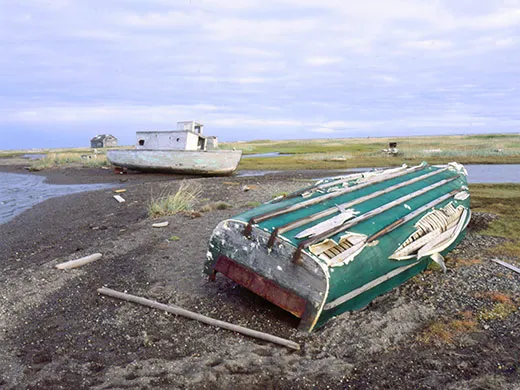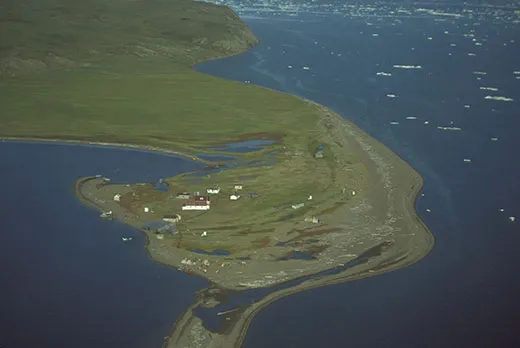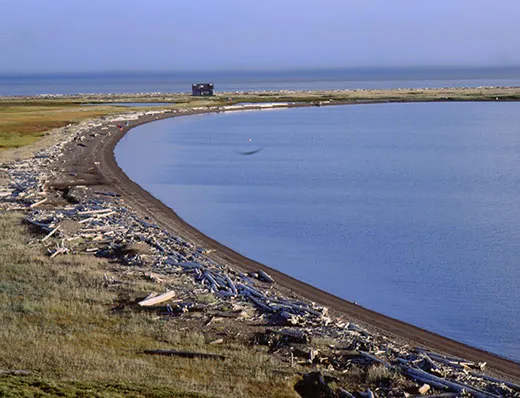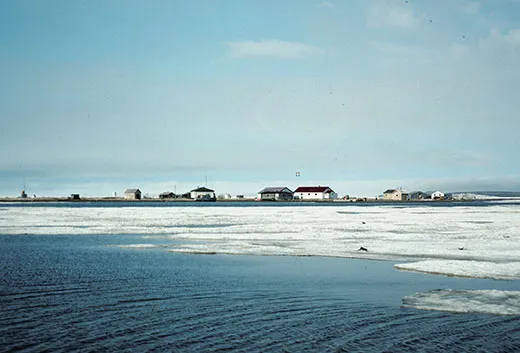Endangered Site: Herschel Island, Canada
An abandoned island off the coast of the Yukon Territory holds a unique place in the history of the Pacific whaling industry
/https://tf-cmsv2-smithsonianmag-media.s3.amazonaws.com/filer/Herschel-Island-Canada-631.jpg)
If you found yourself in the Arctic Circle in winter between the 1890s and early 1900s, then Herschel Island was possibly the best place to be. Hundreds of American men—some with families—would spend months there in the middle of nowhere, their whaling ships trapped by ice as the crewmen waited for warmer weather to pursue their prey, the bowhead whale, through the Beaufort Sea. Herschel Island hosted grand balls, theatrical performances and even sports leagues. The whalers worked hard and played hard—sometimes, too hard. Five men died during a baseball game in 1897 when a blizzard struck before everyone could take shelter.
Then, in 1907, the whaling market collapsed. Petroleum had replaced whale oil and mass-produced steel springs replaced baleen (a flexible material found in bowhead whale mouths). The whalers left the island. Over the next few decades, the Inuvialuit—descendents of the Thule Inuit tribes who left Alaska to colonize the island a thousand years ago, moved to the Mackenzie Delta on the mainland, leaving only the Royal Canadian Mounted Police, who had enforced the laws since 1903. Then, in 1964, the Mounties left as well.
No one lives on Herschel Island now. Located on the coast of the Canadian Yukon, 45 miles east of Alaska but separated from Prudhoe Bay by the Arctic National Wildlife Refuge, it is not the most convenient place to visit. But kayakers traveling down the Firth River visit and cruise ships stop by during the warm months. The Inuvialuit periodically return for days or months to practice the old ways and teach them to a new generation.
Although the ocean has been slowly encroaching on the island for centuries, climate change has sped up the process. Scientists predict that within 50 years, the remaining vestiges of whaling culture and that of its Thule Inuit predecessors, most of which are near the shoreline, will slip beneath the tides. The Canadian government is considering what, if anything, can be done to save the archaeological remnants of Herschel Island's unique history.
"There is no ready and cheap way to deal with Mother Nature and hold her at bay if she has an attitude," says Jeff Hunston, director of heritage resources for the Yukon government.
Mother Nature created Herschel Island almost as an afterthought. During the last Ice Age thousands of years ago, the Laurentide Ice Sheet pushed rock and sediment into a pile at its edge. The ice melted, causing sea levels to rise—and out of the resulting muck appeared the crest of land that Inuit and American whalers would one day call home.
The whole world has warmed since then, but temperatures in the Arctic are increasing twice as fast as the rest of the planet and could rise another ten degrees or more by the end of this century, according to the Intergovernmental Panel on Climate Change. As the ice and permafrost melts, "we're seeing dramatic changes in shoreline," says Wayne Pollard, a coastal geologist and climate scientist at McGill University in Montreal.
Over the years, heaving frost and landslides exposed several Inuvialuit graves dating back to whaling days. Worried about the reactions of tourists to exposed remains, about 15 years ago, officials asked Pollard for advice about how they could stop the degradation. By then, however, part of the archaeological record had already been lost. Many of the oldest relics, left by the Thule Inuit a thousand years ago, washed out to sea in the 1970s and 1980s before they could be excavated.
In 1999, a large storm hurled ice into one of the old whaling buildings, crushing an attached metal shed. Since then, park officials, who now manage the island, moved a couple of structures farther inland, which removed them from their historical context. Meanwhile, nothing is being done to save the island's four graveyards, other than covering any human remains that become exposed. "Dust to dust," Hunston says philosophically.
Even after the coastal archaeological sites are destroyed, the remainder of the island will remain above water for several thousand years. But the Inuvialuit traditions sustained by the Arctic climate may not survive. The Inuvialuit "don't have an oral history for what to do when it's warm," Pollard notes. They hunt from the sea ice, which is becoming unstable, and travel across the water in small boats, which are vulnerable to increasingly unpredictable storms. The caribou could shift their migration patterns, or polar bears could alter their denning sites. "There are all kinds of changes to the natural history that will affect cultural activities," Pollard says.
Damage to Herschel Island's flora and fauna would represent another major loss. Visitors rave about the gorgeous wildflowers and uncommon combination of wildlife. The island is one of the few spots on Earth where black, polar and grizzly bears share the same habitat. There are also moose, musk oxen and caribou, as well as bowhead and beluga whales. "It's the only place I know where you will have the whole food chain hanging out together," Pollard says.
William Fitzhugh, head of the Smithsonian Institution's Arctic Studies Center, sees Herschel Island as just the tip of a melting iceberg, as many other Arctic archaeological sites have begun disappearing. "We're losing a lot of the Arctic record much faster than we were before," he says.
But Doug Olynyk, manager of Yukon's historic sites, puts the potential loss of Herschel Island and other archaeological sites in a broader, vastly more worrisome, perspective. "It will be sad that people won't be able to experience Herschel Island in its true glory, years from now," he says. "But once Manhattan starts being flooded, I don't think people will care about Herschel Island."
Planning Your Next Trip?
Explore great travel deals
Smithsonian magazine participates in affiliate link advertising programs. If you purchase an item through these links, we receive a commission.
/https://tf-cmsv2-smithsonianmag-media.s3.amazonaws.com/accounts/headshot/Sarah-Zielinski-240.jpg)




/https://tf-cmsv2-smithsonianmag-media.s3.amazonaws.com/accounts/headshot/Sarah-Zielinski-240.jpg)